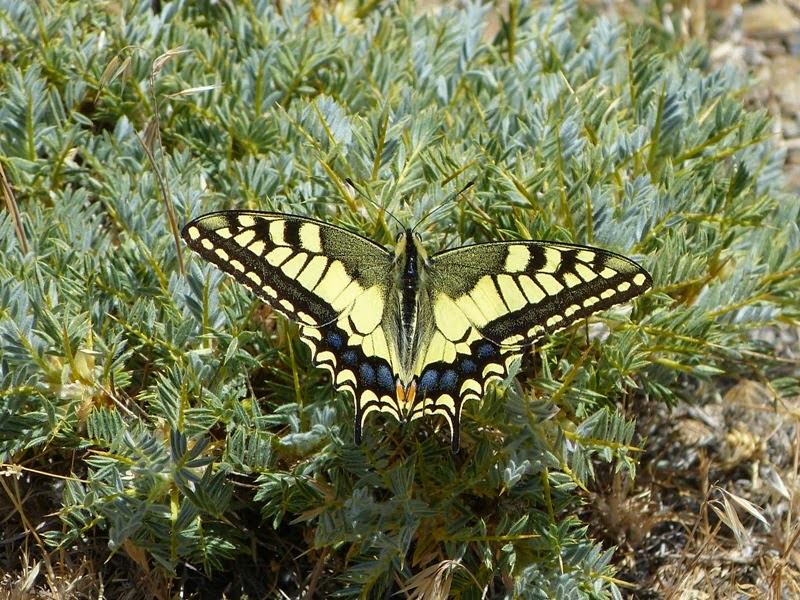Initially, I was surprised not to see any butterflies, but as I walked up to the viewpoint I was amazed to see five Swallowtails, Papilio machaon hispanicus, flying backwards and forwards. I presume this is the "hill topping" activity that I have heard so much about.
The Swallowtails were being bombarded by Wall Browns, Lasiommata megera, every time they flew anywhere near them. It was a great sight to see!
Among them were some Large Wall Browns, Lasiommata maera.
I was delighted to see this Blue-spot Hairstreak, Satyrium spini. I had read about them before I went and I was disappointed to see that they occur in May and June in the Sierra Nevada. However, this one looked quite fresh. Later I saw some much more faded individuals.
As I crouched down to take a picture of the Blue-spot Hairstreak I noticed another butterfly out of the corner of my eye landing on the same plant. It was a Iberian Scarce Swallowtail, Iphiclides feisthamelii. What a dilemma - which to take a picture of?!! I ended up alternating between the two!
The Dusky Heaths, Coenonympha dorus, here were a lot fresher-looking than those back in Alora. There were quite a number here at about 2,100 metres, yet I had seen none 500 metres further up in the mountains.
There were also plenty of Purple-shot Coppers, Lycaena alciphron, in this area.
The Common Blues here were all rather faded, but this Idas Blue, Plebejus idas, was particularly nice. I had thought that this was another Silver-studded Blue, but after help from the UK Butterfly Forum and checking with the "Mariposas Diurnas de Sierra Nevada" book I now know it is an Idas Blue. These have a slightly darker background colour on the underside of their wings and more extensive blue spots.
I was amazed by how many butterflies there were in this small area. If you look carefully at the picture below you can see a dot above the left-hand interpretation board. It is one of the Swallowtails!










The Swallowtails are simply magnificent! What a breathtaking place!
ReplyDeleteHi Maria, it was an amazing spot. I have never previously seen more than one Swallowtail at a time!
DeleteWhat a fabulous view of the Sierra. One would think that in such a remote place with sparse vegetation that very few butterflies would be seen, but au contraire! The Swallowtails are such beauties, haven't seen all that many this year, and never more than two at a time of the same species.Lucky you to have had the pleasure of such a dilemma!:) Great captures of all the butterflies Nick, with their wings so perfectly intact they are a pleasure to see.
ReplyDeleteThanks Sonjia. Yes, I have had it wrong all these years. I always look for flowery, sheltered spots, thinking they would be best for butterflies. I will definitely be heading for the hills on future holidays!
DeleteI'm so glad you weren't discouraged by the difficult parking and found a way to get up there. What a view! But what a great collection of spectacular species as well. I can appreciate the dilemma of which to shoot. So glad you managed to get both! I had a similar situation in Washington last year. I found a little field of wild flowers by the river, and thought bingo. But there wasn't a single butterfly to be found. My husband climbed up the hill to get a better view of the river valley, and he spotted several up there and called me up. What a surprise! Now your experience has confirmed that I need to check out both when able.
ReplyDeleteI have heard people talking about "hilltopping" but never imagined that there would be so many butterflies of different species in the one place. The vegetation was no different from that all around, but it must have been the topography that attracted them. A small mound at the top of a large slope.
DeleteHowever, further down the mountain road I stopped in a more flowery area and saw even more butterflies there!
Hi Nick, this must be hill-topping at its best! The view is spectacular but even I would have thought the place to be void of butterflies - it looks like such an exposed and barren. All the butterflies are lovely. I especially like the Purple-shot coppers, which look quite unusual since their wings are bright orange but their bodies are covered in bright blue hairs!
ReplyDeleteJonny,
DeleteIt just shows how wrong I have been on my previous visits to Spain. In the summer so much of Spain is really parched and dry. I have always searched out green vallies thinking there would be more flowers and therefore butterflies there. I suppose the altitude of the Sierra Nevada makes things different. A small meadow lower down had even more butterflies!! Having been there once I really want to go back!